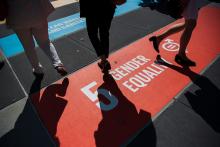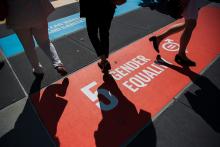1. Lack of women in leadership
With just 27 per cent of parliamentary seats, 36 per cent of local government seats, and 28 per cent of management positions held by women, there is a lack of diverse perspectives in decision-making processes, hindering comprehensive policy formulation.
2. Poverty and lack of economic opportunities
More than 340 million women and girls are projected to live in extreme poverty by 2030. This represents a staggering 8 per cent of the global female population surviving on less than USD 2.15 a day. Social protections, access to decent work, and other support systems are urgently needed to provide a path out of poverty.
3. Workplace discrimination and inequalities
Only 61 per cent of prime working-age women participate in the labour force, compared to 91 per cent of prime working-age men. This affects both economic growth and societal progress. In 2019, for each dollar men earned in labour income, women earned only 51 cents.
4. An imbalance in unpaid care work
On the current trajectory, the gap between the time spent by women and men on unpaid care will narrow slightly, but by 2050, women globally will still be spending 9.5 per cent more time (2.3 more hours per day) on unpaid care work than men. This persistent gap limits women’s participation in education, employment, and other opportunities.
5. Social norms and cultural practices
Harmful practices such as child marriage and female genital mutilation persist. Globally, one in five young women is married before age 18. The prevalence of child marriage highlights the need for attitudinal shifts and the promotion of legal frameworks that safeguard women and girls’ rights.
6. Inadequate access to education and health care
An estimated 110 million girls and young women may remain out of school by 2030. Stalled progress in reducing maternal mortality and expanding educational opportunities call for targeted interventions to meet the 2030 goals.
7. Food insecurity
Nearly 24 per cent of women and girls are expected to experience moderate to severe food insecurity by 2030. Empowering women in food and agricultural systems by enhancing access to land and resources is vital for ensuring food security and economic growth.
8. Violence against women and girls
Each year, 245 million women and girls experience physical and/or sexual violence by an intimate partner. Older women also face higher rates of poverty and violence than older men.
9. Inadequate funding for gender equality initiatives
Only 4 per cent of total bilateral aid is allocated to gender equality and women’s empowerment. The additional investment needed for achieving gender equality by 2030 is estimated at USD 360 billion per year.
10. Legal barriers and poorly enforced legislation
At least 28 countries do not have laws granting women equal rights to enter marriage and initiate divorce, and 67 countries lack laws prohibiting direct and indirect discrimination against women. Where legislation does exist to promote gender equality, effective implementation remains a challenge.
11. Lack of access to clean energy and sanitation
An estimated 341 million women and girls are projected to lack electricity by 2030. Universal access could significantly reduce poverty and improve women’s health.
With just seven years remaining to achieve the 2030 targets, concerted efforts and funding are more necessary than ever. Each step forward, no matter how incremental, brings us closer to a future where gender equality is not just a goal, but a reality.

